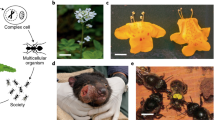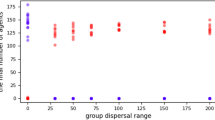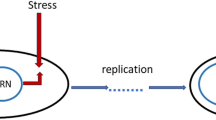Abstract
At the start of life, the origin of a primitive genome required individual replicators, or genes, to act like enzymes and cooperatively copy each other. The evolutionary stability of such enzymatic cooperation poses a problem, because it would have been susceptible to parasitic replicators that did not act like enzymes but could still benefit from the enzymatic behaviour of other replicators. Existing hypotheses to solve this problem require restrictive assumptions that may not be justified, such as the evolution of a cell membrane before the evolution of enzymatic cooperation. We show theoretically that, instead, selection itself can lead to replicators grouping themselves together in a way that favours cooperation. We show that the tendency to physically associate with others and cooperative enzymatic activity can coevolve, leading to the evolution of physically linked cooperative replicators. Our results shift the empirical problem from a search for special environmental conditions to questions about what types of phenotypes can be produced by simple replicators.
This is a preview of subscription content, access via your institution
Access options
Access Nature and 54 other Nature Portfolio journals
Get Nature+, our best-value online-access subscription
$29.99 / 30 days
cancel any time
Subscribe to this journal
Receive 12 digital issues and online access to articles
$119.00 per year
only $9.92 per issue
Buy this article
- Purchase on Springer Link
- Instant access to full article PDF
Prices may be subject to local taxes which are calculated during checkout


Similar content being viewed by others
Data availability
There are no data to report.
Code availability
All code has been made available, along with an implementation of the calculations, in Supplementary Software 1, and is available on GitHub at https://github.com/srlevin/sticky.git.
References
Eigen, M. Selforganization of matter and the evolution of biological macromolecules. Naturwissenschaften 58, 465–523 (1971).
Eigen, M. & Schuster, P. A principle of natural self-organization. Naturwissenschaften 64, 541–565 (1977).
Maynard Smith, J. & Szathmary, E. The Major Transitions in Evolution (Oxford Univ. Press, 1995).
Bourke, A. F. Principles of Social Evolution (Oxford Univ. Press, 2011).
Maynard Smith, J. Hypercycles and the origin of life. Nature 280, 445–446 (1979).
Szathmáry, E. & Demeter, L. Group selection of early replicators and the origin of life. J. Theor. Biol. 128, 463–486 (1987).
Frank, S. A. Kin selection and virulence in the evolution of protocells and parasites. Proc. R. Soc. Lond. B Biol. Sci. 258, 153–161 (1994).
Zintzaras, E., Santos, M. & Szathmáry, E. ‘Living’ under the challenge of information decay: the stochastic corrector model vs. hypercycles. J. Theor. Biol. 217, 167–181 (2002).
Bianconi, G., Zhao, K., Chen, I. A. & Nowak, M. A. Selection for replicases in protocells. PLoS Comput. Biol. 9, e1003051 (2013).
Zintzaras, E., Santos, M. & Szathmáry, E. Selfishness versus functional cooperation in a stochastic protocell model. J. Theor. Biol. 267, 605–613 (2010).
Boerlijst, M. C. & Hogeweg, P. Spiral wave structure in pre-biotic evolution: hypercycles stable against parasites. Physica D Nonlinear Phenomena 48, 17–28 (1991).
Boerlijst, M. C. & Hogeweg, P. Spatial gradients enhance persistence of hypercycles. Physica D Nonlinear Phenomena 88, 29–39 (1995).
Cronhjort, M. B. & Blomberg, C. Cluster compartmentalization may provide resistance to parasites for catalytic networks. Physica D Nonlinear Phenomena 101, 289–298 (1997).
McCaskill, J. S., Füchslin, R. M. & Altmeyer, S. The stochastic evolution of catalysts in spatially resolved molecular systems. Biol. Chem. 382, 1343–1363 (2001).
Szabó, P., Scheuring, I., Czárán, T. & Szathmáry, E. In silico simulations reveal that replicators with limited dispersal evolve towards higher efficiency and fidelity. Nature 420, 340–343 (2002).
Sardanyés, J. & Solé, R. V. Spatio-temporal dynamics in simple asymmetric hypercycles under weak parasitic coupling. Physica D Nonlinear Phenomena 231, 116–129 (2007).
Shay, J. A., Huynh, C. & Higgs, P. G. The origin and spread of a cooperative replicase in a prebiotic chemical system. J. Theor. Biol. 364, 249–259 (2015).
Higgs, P. G. & Lehman, N. The RNA world: molecular cooperation at the origins of life. Nat. Rev. Genetics 16, 7–17 (2015).
Levin, S. R. & West, S. A. The evolution of cooperation in simple molecular replicators. Proc. R. Soc. Lond. B Biol. Sci. 284, 20171967 (2017).
Metz, J. A., Nisbet, R. M. & Geritz, S. A. How should we define ‘fitness’ for general ecological scenarios? Trends Ecol. Evol. 7, 198–202 (1992).
Rand, D. A., Wilson, H. & McGlade, J. M. Dynamics and evolution: evolutionarily stable attractors, invasion exponents and phenotype dynamics. Phil. Trans. R. Soc. Lond. B Biol. Sci. 343, 261–283 (1994).
Geritz, S. A., Metz, J. A., Kisdi, É. & Meszéna, G. Dynamics of adaptation and evolutionary branching. Phys. Rev. Lett. 78, 2024 (1997).
Dieckmann, U. & Law, R. The dynamical theory of coevolution: a derivation from stochastic ecological processes. J. Math. Biol. 34, 579–612 (1996).
Van Baalen, M. & Jansen, V. A. Dangerous liaisons: the ecology of private interest and common good. Oikos 95, 211–224 (2001).
Hurford, A., Cownden, D. & Day, T. Next-generation tools for evolutionary invasion analyses. J. R. Soc. Interface 7, 561–571 (2009).
MaynardSmith, J. & Price, G. The logic of animal conflict. Nature 246, 15–18 (1973).
Hamilton, W. D. The genetical evolution of social behavior. I. J . Theor. Biol. 7, 1–16 (1964).
Hamilton, W. D, The genetical evolution of social behavior. II. J. Theor. Biol. 7, 17–52 (1964).
Frank, S. A. The origin of synergistic symbiosis. J. Theor. Biol. 176, 403–410 (1995).
Frank, S. A. Foundations of Social Evolution (Princeton Univ. Press, 1998).
Foster, K. R. & Wenseleers, T. A general model for the evolution of mutualisms. J. Evol. Biol. 19, 1283–1293 (2006).
Gardner, A., West, S. A. & Barton, N. H. The relation between multilocus population genetics and social evolution theory. Am. Nat. 169, 207–226 (2006).
Wyatt, G., West, S. & Gardner, A. Can natural selection favour altruism between species? J. Evol. Biol. 26, 1854–1865 (2013).
D’Souza, G. et al. Ecology and evolution of metabolic cross-feeding interactions in bacteria. Nat. Prod. Rep. 35, 455–488 (2018).
Law, R. & Dieckmann, U. Symbiosis through exploitation and the merger of lineages in evolution. Proc. R. Soc. Lond. B Biol. Sci. 265, 1245–1253 (1998).
Queller, D. C. Expanded social fitness and Hamilton’s rule for kin, kith, and kind. Proc. Natl Acad. Sci. USA 108, 10792–10799 (2011).
Cooper, G. A. & West, S. A. Division of labour and the evolution of extreme specialization. Nat. Ecol. Evol. 2, 1161–1167 (2018).
Takeuchi, N., Hogeweg, P. & Kaneko, K. The origin of a primordial genome through spontaneous symmetry breaking. Nat. Commun. 8, 250 (2017).
Acknowledgements
We thank G. Cooper and S. Frank for helpful comments on the manuscript. S.R.L. is supported by The Clarendon Fund, Hertford College and NERC. S.G. is supported by the Leverhulme Trust (visiting professorship grant).
Author information
Authors and Affiliations
Contributions
S.R.L. and S.A.W. conceived of the manuscript. The modelling was carried out by S.R.L. and S.G. All authors contributed equally to the final presentation of the manuscript.
Corresponding author
Ethics declarations
Competing interests
The authors declare no competing interests.
Additional information
Publisher’s note Springer Nature remains neutral with regard to jurisdictional claims in published maps and institutional affiliations.
Supplementary information
Supplementary Information
Supplementary Figs. 1 and 2, Table 1, discussion, models and references.
Supplementary Software 1
Mathematica notebook containing all of the numerical calculations and code for generating the figures.
Rights and permissions
About this article
Cite this article
Levin, S.R., Gandon, S. & West, S.A. The social coevolution hypothesis for the origin of enzymatic cooperation. Nat Ecol Evol 4, 132–137 (2020). https://doi.org/10.1038/s41559-019-1039-3
Received:
Accepted:
Published:
Issue Date:
DOI: https://doi.org/10.1038/s41559-019-1039-3
This article is cited by
-
A PDE Model for Protocell Evolution and the Origin of Chromosomes via Multilevel Selection
Bulletin of Mathematical Biology (2022)
-
From self-replication to replicator systems en route to de novo life
Nature Reviews Chemistry (2020)
-
The early origin of cooperation
Nature Ecology & Evolution (2019)



